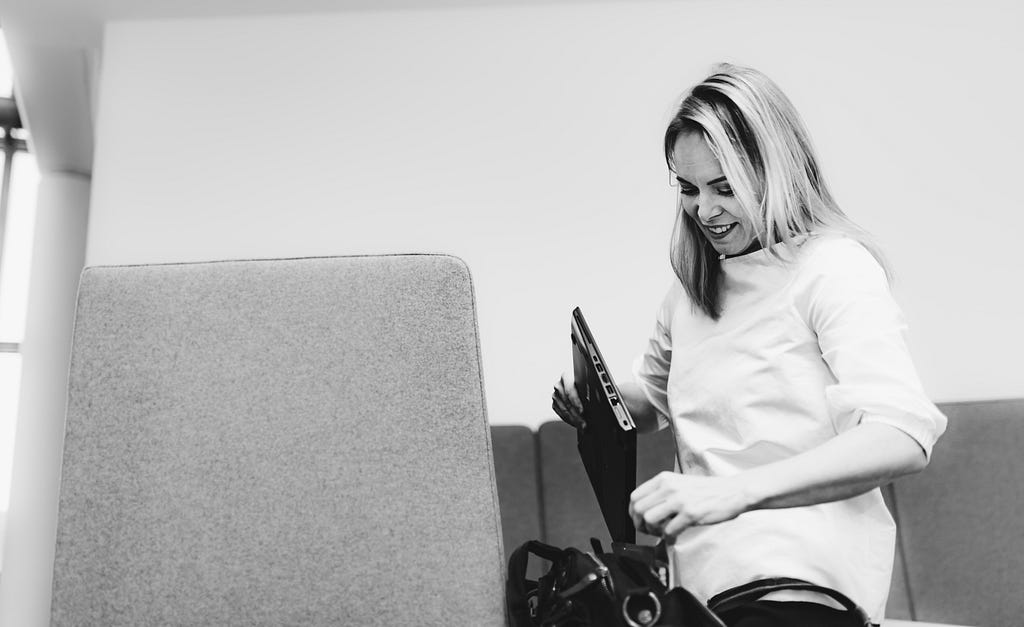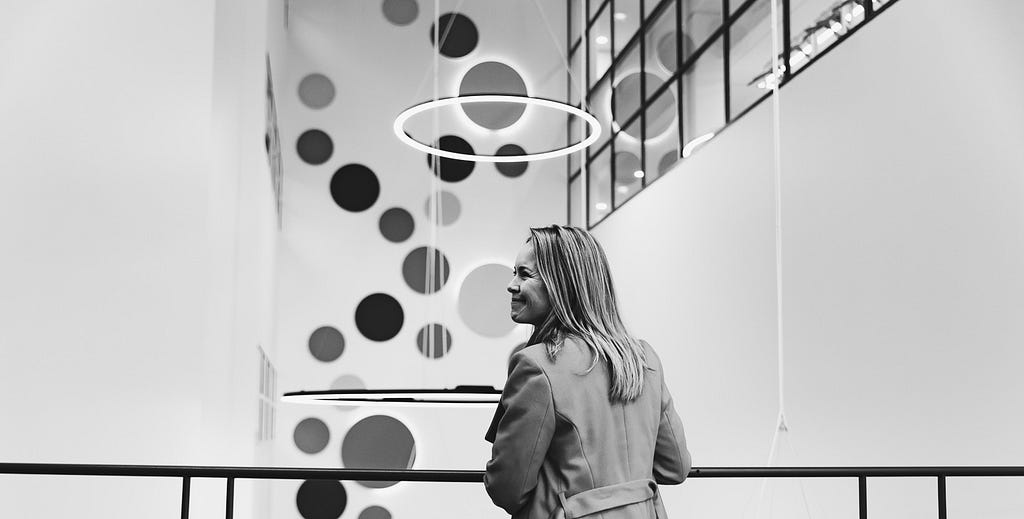Ten Lessons from a Change Agent
What does it take to transform corporations like the now-merged RAY, newly-branded Telia, and the traditional VR group into customer centric, digitally-minded organizations?
We sat down with Vanessa Lehtinen, the current head of VR Group’s digital services and marketing, to discuss the process and challenges of successful change management and transformation. Here’s what she had to say:
Part 1: The Importance of Vision
“Change is something that cannot happen without the full support of the management team. That’s one of the things I have learnt through my experiences working with transformation companies RAY (the former Slot Machine Association of Finland), Telia (one of the biggest tele operators in the Nordics) and now the VR Group (Finland’s government-owned railway company).
Leadership is vital. Somebody on the very top needs to have a clear vision on where to go, what to achieve and how to lead us there. But at the same time the change makers, the people responsible for the transformation, need to be given a certain amount of trust.
We don’t usually want or need to be told exactly what to do, just showing the right direction is enough. There must be room for creativity. Change and a modern customer-centric approach takes courage. It is always easy to go back to the old patterns and choose to make safe decisions by not making them at all.
Setting goals and objectives is crucial. For me at least it is important to know, both in the short and long term, why are we doing this and what are we trying to accomplish? Change needs to have a purpose. Every case, company and brand is different, as are the circumstances. There is no certain timeline or pattern on how to do things. Often progressing step by step is the right thing to do. But change without a purpose is usually always pointless.”

Part 2: The Meaning of Communication
“Probably the most important early step of change management is to find the right people to lead the transformation. Lobbying and selling ideas internally to the core team is relatively simple. Scaling up inside the company has proved much more difficult. At Telia, for example, we made a misjudgment when we were trying to force our views and not involving enough people. Subsequently, we failed to create adequate excitement and were unable to get enough motivated people on board.
Everyone does not need to agree on everything because that leads nowhere, but it is vital that the team responsible for the transformation listens what people inside the company have to say.
In addition to management, employees need to be included as well. Sometimes overdoing is required. When I started here at the VR Group in 2018, information was not moving too smoothly internally. There were communication issues, so I made a conscious decision to try to involve everyone as much as possible.
I encouraged everyone to be open and transparent, share information, roadmaps and schedules, ask opinions, hold workshops, repeatedly explain what we are trying to achieve and why and how, and use whiteboards and post-its on the hallways and walls of our offices. We also hold open demo sessions, and instead of having an office or even a desk, I work in an open space that is easily reachable.
There has been progress but there’s still a lot of work to be done in communication. Without openness and transparency, including internally within your own team of course, the change simply cannot happen smoothly if at all. We are working on it. Money, however, is usually not the main issue. Thinking, after all, is free.”

Part 3: Ten Things to Consider in Change Management
1. Realistic vision
“The vision always needs to be clear enough that everyone involved understands the core purpose of the company’s direction, and what is required of the desired transformation. People need to know what is expected of them. The vision needs to be also real and achievable. Not just fancy words and graphics in a PowerPoint.”
2. Understanding and openness
“Even the clearest of visions still needs to be sold within the company. Communication is the key. How do you get employees to believe in that vision? What does the vision actually mean for them? What are the common everyday actions that will change during and after the desired transformation? A shared understanding of that vision is needed.”
3. Honest motivation
“The change simply cannot be successful unless people want it to happen. The company as a whole needs to be motivated to go through the transformation.”
4. Leadership and trust
“No change can be successful without the support of the management. Still, there needs to be room for creativity and freedom to experiment in different scenarios. If not, motivation dies. Leadership is vital, but so is trust.”
5. Positive attitude
“Saying ‘thank you’ and giving credit for a job well done, even with small tasks, is crucial. Negativity and bad manners kill the spirit. And if the spirit is gone, things will get very difficult.”
6. Problem of the status quo
“People can find the transformation process scary, because it changes the status quo for them personally. Especially in the bigger companies there is always a group of individuals who will resist the change, no matter how clear the vision and communication may be.”
7. Importance of trust
“The feeling of safety is vital for everyone. For example repeatedly surviving co-operation negotiations creates an environment where trust is no longer there. Telia was an example of a company where all employees understandably were not fully open for transformation, because they had just survived yet another co-operation negotiation. That led to a situation in which some were more interested in protecting their own positions than being involved in the change. There was not enough true trust, openness or communication.”
8. Tackling mental bureaucracy
“Sometimes, I am afraid, laziness can be a challenge too. Not everyone is willing to learn new things and change their thinking and working habits. The actual bureaucracy unfortunately is also an obstacle. Letting go of useless hierarchy is a surprisingly hard thing to do.”
9. Goals and measuring
“Change without a purpose is usually meaningless. It is also important that the variables during the transformation are measurable. Numbers, data, analytics and statistics give proof and guidance.”
10. In-house talent
“In short, any transformation requires the right people internally with the right knowledge, with the right attitude, in the right position.”

Part 4: The Role of Consultants
“A successful transformation process often requires using consultants. Still, balance between the in-house and outsourced talent is crucial.
Rather than superior experts, consultants need to be equal partners, almost like co-workers.
When I was younger, I too used to respect the views of consultants too much. At Telia we struggled with the same issues. At times it felt like nothing could be achieved without having the clearance from a consultant first.
Honesty is also vital. If consultants disagree, they need to say it out loud. Consultants cannot be overly polite and play nicely just because they fear losing the client over criticism. The same goes with the aftermath. If consultants have all the knowledge and information of the transformation process, it is obviously not good. On the other hand, if all the knowledge is within the company, that is a risk too. Again, balance is key.”
Part 5: The Art of Buying
“The most important skill for a buyer is to know what to buy. Often a buyer simply fails to communicate what kind of consultancy is wanted. We had this issue at Telia sometimes: We bought something, an agency did their best, we were not happy, we changed the office and repeated the pattern.
It’s crucial to have a good brief for an agency. On the other hand, some consultants tend to oversell.
It should not be a buyer-seller relationship but an equal co-operation that benefits both sides.
The process of buying has also changed. Instead of projects, we at VR Group think of transformation as a continuous change that is never 100% complete. Usually it’s a good idea to use consultants from more than just one agency at a time.
Physical presence is also important. Consultants don’t need to sit at the client’s office 24/7 but they must deliver more than just emails and presentations. And consultants need to remember that it is not just about presenting new ideas every week but actually executing those that have already been approved. Trust and mutual respect is everything.”

Part 6: Short Case Study RAY
Head of Digital Service 2012–2014
“The transformation process at the RAY (now Veikkaus) was pretty smooth at the time. The vision was clear, and so was our goal: RAY wanted to offer online games. That was the mission. The support of the leadership was there. The budget was sufficient. Communication worked.
Interestingly enough our digital team that grew from 10 to 50 was not working at the RAY headquarters but we had our own isolated office space in the greater Helsinki area at Vantaa. It turned out to be an excellent solution. We were like a startup inside the major corporation.
Since the vision was crystal clear, motivating people was easy. Excitement was there throughout the transformation process, and that grew over time.
Strangely enough I don’t recall anyone ever talking about a “customer centric approach” or “user experiences.” Those terms simply just didn’t exist there yet. In hindsight, it’s easy to say that even if our isolated approach worked well during the developing stage, we should have included the rest of RAY’s employees in the process earlier. In other words, integration of the new digital ways of thinking should have been implemented into the company on a wider scale by involving more people and communicating better.”

Part 7: Short Case Study Telia
Head of Digital UX/CX 2014–2017
“To be frank, the change management process at Telia was not optimal. At first, we talked a lot about brand and user experience and about the direction where the massive tele operator wanted to go, but nothing happened because the vision was unclear. There were all sorts of trust issues, and the shared understanding of what we were trying to achieve simply wasn’t there.
When we finally succeeded in creating the transformation strategy, things progressed smoothly for a while, but with changes in top management the vision sort of fell apart. Surely our team, and I personally, made mistakes too.
We were trying to change the big company with too few people. We should have included the rest of the employees better.
Also, the choice of terminology is important in the transformation. Our team, for example, did talk a lot about “customer experience” which understandably clashed with the “customer insights” team of Telia.
Still, the biggest issue at Telia was this: At the same time as we were trying to accomplish the transformation, the company itself was in the middle of a huge transition (Sonera and Tele Finland became Telia Finland) that had already secretly taken place. Some of the people knew about it, most did not. NDAs were everywhere, and because of the situation, we could simply not involve enough people to make the change management more effective and pleasant. There was no openness or transparency. The timing was just off.”
Part 8: Seven Small Things to Remember
1. Be Curious
“Always ask dumb questions. Both internally and from the customers and users as well.”
2. Have fun
“Don’t take yourself too seriously. It’s ok to be ambitious and relaxed at the same time.”
3. Challenge hierarchy
“Don’t be afraid to question decisions. Your opinion matters.”
4. Draw things
“Yes, I literally draw things, with pen and paper. Personally, it helps me to think and often breaks the ice in the meetings.”
5. Speak human
“There is nothing worse than using rhetoric and terms that are packed with bureaucracy and transformation jargon.”
6. Get out of the office
“When you are in the service design and user experience business, it is probably a good idea to meet those users in their own surroundings and see how your product or service really works.”
7. Listen
“Data and analytics are important but not as important than actually listening to what the end-users have to say. Hear them out.”

Part 9: The Present and the Future of VR Group
Head of Digital Services & Marketing 2018–
“The big vision that the VR Group has, of course, is to win the upcoming competitive tenders, and maintain our position as the leading railroad services provider in Finland even after the government-guaranteed monopoly is over.
The only way to succeed is to change our company into a more customer-centric one.
In other words, customer satisfaction needs to be high enough for people wanting to repeatedly use our services. Simultaneously the business must be profitable, but it all starts with the user experience. Our customers should have a true connection with our services. They should feel that travelling by train is important, a choice and a social decision that they make.
Undoubtedly this transformation will require rationalisation, but for me that is a positive thing. When done right rationalisation brings purpose and makes the focus clearer. The worst thing is to make changes that are useless and serve nothing or no one.
We want to be a more personal travelling partner. How do we serve you the best throughout your journey from point A to point B?
Digital services are opening a lot of possibilities to be more than just an online ticket shop. Our apps and screens should be more informative and give real value throughout the customer journey: ‘The next stop lasts seven minutes, please go outside to have fresh air or walk your dog’. ‘We are on schedule, sleep tight’. ‘There is fresh bread to be served, please go to the restaurant car if you’re hungry’. Small but meaningful notes like that.
It is also vital for VR Group to have a social mission and a role in our society. To make people want to choose the train instead of cars or planes, for the sake of the environment. And also, of course, to make the actual journey smoother. Keep the trains on time to begin with. That is the minimum requirement.
But none of this can happen if the organization itself is dysfunctional. That is why there needs to be openness, transparency and communication. It goes without saying that there is still a lot of work ahead at the VR Group before 2026. We are trying our best.”

Part 10: The Last Lesson of Change
“Based on my experiences in all three transformation companies that I have worked with I have learnt the following: Sometimes change requires very little time and almost no money at all.
Let’s use VR Group’s online ticket store as an example. For years customers were understandably complaining why the store does not work 24/7. Well, it turned out that the system previously needed an automatic update every night and therefore needed a break. Too long the mindset within VR was that there was no need for change as it has always been like this. When we digged into “why?” it literally took us five minutes to fix our online ticket system. Now the store is open 24/7. Sometimes change can happen just like that. Minimal cost, massive impact, by asking those silly questions.”
Words by Antti J. Peltonen. Photos by Teppo Kotirinta.
Nordkapp is an advanced design studio. We work together with change makers like Vanessa to transform companies into more customer centric and digital state of mind.
Read more about the work with Telia here and stay tuned for our work with VR!
What kind of transformation are you looking forward to making —cultural, strategic, product or numbers? Ari Heinonen is happy to discuss how to get there and how we can help. Reach Ari at ari@nordkapp.fi or +358 50 386 6348
And if you’re in Benelux, get in touch with Matti Mölsä at matti@nordkapp.fi or +358 40 727 3094
Ten Lessons from a Change Agent was originally published in Future is Present Tense on Medium, where people are continuing the conversation by highlighting and responding to this story.